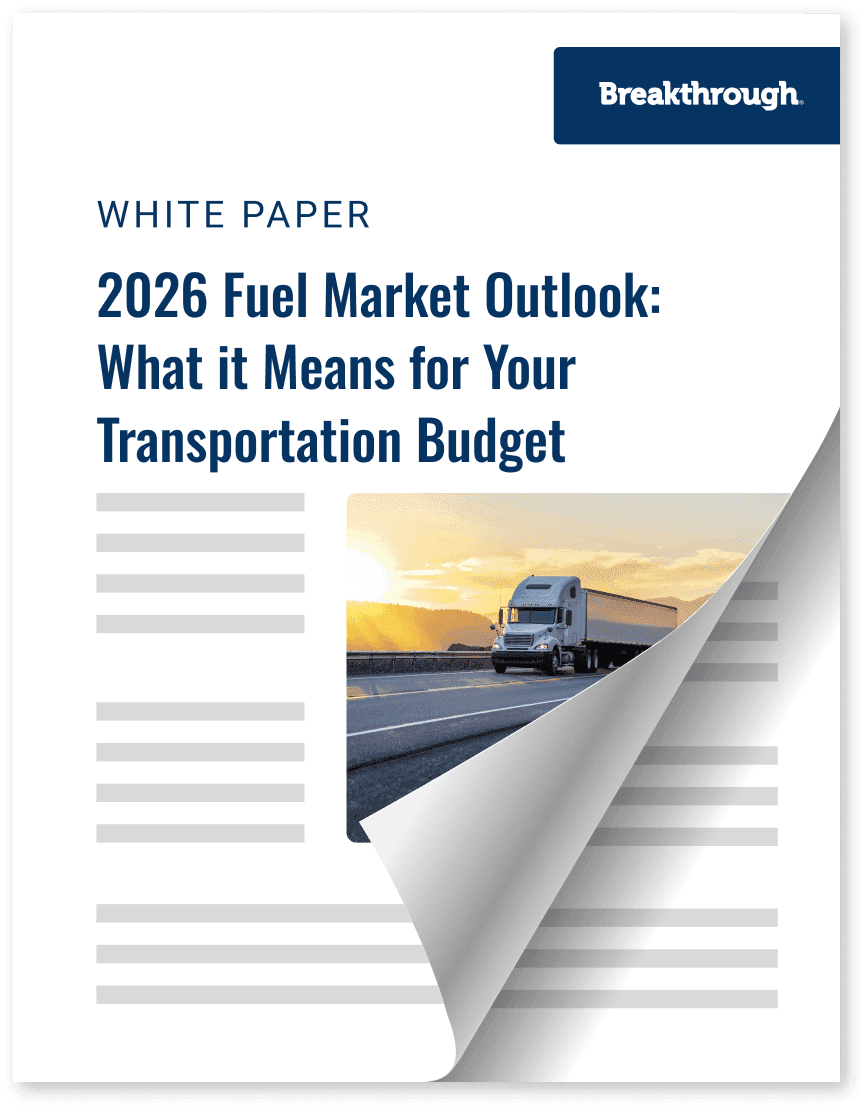2026 Fuel Market Outlook: What it Means for Your Transportation Budget

Trending
Top Posts
12 min read
December 29, 2020

Share:
Table of contents
Browse the table of contents to jump straight to the part you’re looking for
Throughout 2020 the term “unprecedented” was the buzzword of the day for all industries, but even more so for transport and logistics trends. Every corporate email, blog post, report, and headline seems to heavily lean on this language, and despite its fatigue across publications, it remains accurate and relevant to the turbulence of 2020.
When we reflect on all that our shipper clients faced throughout the year, it is difficult to weed through the supply chain chaos brought on by the pandemic. From crude oil to freight flows, unemployment, and the general shift in consumer behavior, records were set and our “new normal” in transportation and logistics will continue to evolve well into 2021.
Below is a list of past market events, emerging trends across the supply chain industry, and an analysis of how some of these unprecedented 2020 events will continue to influence transportation strategies moving forward.
The Organization of Petroleum Exporting Countries (OPEC) and its allies (+) agreed to aggressively reduce crude oil production in an attempt to balance the market and restore prices during the height of COVID-19’s demand destruction earlier in 2020. OPEC members pledged roughly 6.1 million barrels per day (mmbd), while their additional allies (OPEC+) pledged an additional 3.6 mmbd for a whopping total just shy of 10 mmbd. The cuts were set to incrementally decrease over time, starting with 9.7 mmbd for May and June, reducing to 7.7 for the rest of 2020 and then enduring at 5.8 until April 2022.
The need to reduce at such a drastic rate comes on the heels of a price war between Saudi Arabia and Russia, historically high U.S. production levels, and exacerbated demand shocks from coronavirus lockdowns. The result was an overwhelming surplus of crude oil supplies that sent crude oil prices careening into the negative.
Most member countries achieved compliance with the group’s collective 9.7 and 7.7 mmbd cuts from May-August and September-December, respectively

These cuts, while warranted, are now the cause of contention inside OPEC+ meeting rooms. Producers have grown wary about continuing to restrict production and concede market share. This is especially true since output in some competing nations has started to rebound as a result of more favorable market conditions.
The group planned to bring back nearly 2 mmbd of production beginning in January 2021 and follow that course for 15 months. The progressive shift in market dynamics, however, and the potential lack of need for more supply, complicated the cadence and terms of future negotiations. OPEC+ will now take a more conservative approach and reassess the market monthly.
In doing so, they are expected to make minor production adjustments until they have a holistic grasp on the COVID-19-dependent demand outlook and the market’s general direction. The divide between some countries’ goal of rebuilding market share and others of boosting prices at the expense of raising production leaves longer-term OPEC+ supply contributions unclear.
With that in mind, it is important to make a separate mention of the plunge in crude oil prices experienced on April 20th, 2020. As demand sunk for crude oil and refined products, the excessive production on the supply side tipped the scales of the supply and demand balance leading to a flooded market.
Read more about the factors that instigated this crude oil market event in Breakthrough’s blog, “Why Crude Oil Prices Fell Below Zero.”
This became particularly problematic for crude oil futures contract holders at the time. Most often, these entities simply buy and sell futures contracts without ever physically having barrels of crude oil in their possession. But in April 2020, when futures contracts were set to expire and the country’s storage and infrastructure were near capacities, futures traders were literally left with millions of barrels they couldn’t sell, store, or move. The result: prices were driven so low they would pay to have oil taken off their hands, which was additionally reflected in unpalatably low gasoline, jet fuel, and diesel fuel prices.
Most crude oil price volatility in 2020 was directly connected to the demand destruction associated with the pandemic. The sweeping lockdowns and movement restrictions that followed the virus’ spread took with it the need for transport fuels and the crude oil required to produce them.
Despite the historic oil price crash seen in Q2, the oil market’s cyclical nature soon lifted prices out of the depths and into positive territory.
Prices remained abnormally low in the $15-$30 per barrel range temporarily before gradually rising on the back of global supply restraints and a cautious demand rebound through the summer. The pandemic’s unwavering spread continued to weigh on market fundamentals and prices until the materialization of vaccine optimism reversed the narrative toward the end of 2020.
Read how coronavirus vaccine distribution may, or may not, influence the freight market and capacity in 2021.
Now, the targeted rollout of a viable vaccine appears to have pushed the energy market in the right direction, albeit timelines around a full-fledged recovery remain in question. Oil prices have settled into the rangebound territory between $40-$50 per barrel in recent weeks, a far cry from the sub-zero mark that was hit in April.
The U.S. oil industry was expanding rapidly in the years leading up to 2020. The government’s push to become energy independent and assert the country as a global energy powerhouse propelled the nation up the world energy ranks.
Ever since the shale oil boom in the 2000s, made possible by advancements and use of fracking, U.S. crude oil production has become increasingly efficient, making the increases possible. As a country, we achieved energy independence in late November 2018, and have continued a nearly steady upward trajectory until the dramatic dip felt in March of 2020.
In early 2020, domestic crude oil production surpassed 13 mmbd, making the U.S. the world’s largest producer and one of the most influential players in the international energy landscape. Then, the COVID-19 pandemic changed this trajectory.
The crude oil price crash made it economically unviable for oil companies to keep their taps open. In turn, domestic oil production fell by more than 25 percent to less than 10 mmbd in August, the lowest output totals since January 2018. The rapid decline in domestic production essentially led the U.S. to give back nearly three years of the growth it had gained in the middle of its climb toward world energy prominence.
Domestic oil production has recovered to about 11 mmbd as producers are finally able to turn a profit with oil prices north of $45 per barrel. These recent gains might soon stall because inflated inventories may lead to a price plateau as we await more widespread distribution of the COVID-19 vaccine.

Because of the relationship between crude oil prices and the cost of its refined products like gasoline, diesel, and other products, wholesale diesel hit its lowest price in the history of Fuel Recovery, Breakthrough’s market-based fuel reimbursement service offering.
Crude oil is one of the largest and most volatile components of the diesel price buildup. Any major oil price swings often lead to a comparable price change at the pump, at least directionally. So, like the oil price crash endured in the second quarter, diesel prices followed suit. The same market forces that tanked the oil market drug wholesale diesel prices down to their lowest level seen in the 16-year history of Breakthrough.

Since falling to below $1.40 per gallon in April, the wholesale diesel market has slowly but surely bounced back. A myriad of factors contributed to this behavioral price shift, but most of the price gains seen in the past six months have been tied to the momentum in the crude oil market. Another important factor is diesel’s resilience due to its prominence in commercial transportation. At present, national average wholesale diesel prices are over $2.20 per gallon. This is a price point last seen in February before COVID-19 was a major issue in the United States.
Breakthrough Fuel Recovery clients realize the value of our fuel reimbursement solution on every movement, every day. But in times of heightened uncertainty when prices swing very quickly, this value is maximized. In Q2 of 2020, market conditions led to an average of nearly 74 cent savings on a per-gallon basis—which is nearly 25 cents beyond the previous year-averaged record. The DOE-to-wholesale spread also hit its highest single-day record on April 27, surpassing 114 cents per gallon.
Spreads were about 40 percent higher in 2020 than in 2019 and closed the year over 55 cents per gallon. This mark is not entirely indicative of the milestones achieved this year, though. Spreads topped out at nearly $1.15 per gallon at a national level and remained over 50-60 cents for most of the year. The recent upside price pressure in the crude oil and diesel market has brought spreads down to more normal levels between 30-40 cents per gallon, but the Breakthrough Advantage remains strong.
Spreads tend to be more advantageous in a downward trending fuel market since retail prices rarely move at the same pace or magnitude as the wholesale market. With this in mind, Breakthrough clients saved more on fuel in 2020 than they ever had before. The pandemic’s energy market influence caused massive a differential (i.e. spread) between fuel prices under a traditional fuel reimbursement method and those captured by Breakthrough. This ultimately shined a bright light on the value of a market-based fuel management program and significantly lowered client fuel spend.
The wider industry trends in 2020 have resulted in economic activity that surpasses many previously experienced extremes.
While many of these are not directly reflective of transportation trends, freight volumes, and other sector-specific indicators, each is interconnected with the way consumers and organizations purchase goods, and in turn, will continue to affect supply chains.
Understanding how economic activity and consumers will influence your unique transportation network will be crucial to navigating your strategic roadmap in 2021.
The truck transportation industry lost 96,700 jobs in March and April, representing the largest one-month drop on record. As the entire economy suffered from job losses, transportation was no exception. The one-month drop is equivalent to losing all the trucking jobs created since November 2014.
Since the sudden drop, truck transportation only has regained roughly 43,800 jobs while the industry competes with other more attractive blue-collar professions, like warehousing, residential construction, and local delivery jobs.
Interested in looking back? See what trends had been predicted by industry experts prior to 2019, here.
Past transportation market trends have heavily focused on autonomous vehicles, transportation technologies, artificial intelligence, alternative energies, and other technology to improve the efficiency of the industry as a whole. These recent trends in transportation are still prevalent but have taken a backseat as shippers and carriers alike are forced to adapt in real-time to the rapid shifts felt across major cost buckets in their strategies.
Paying attention to disruption can not only bring context and clarity to challenges and successes manifesting operationally today, but it can also help pave the way for better navigation and strategic vision in the long-term
For more information about industry trends, visit our blog.

6 min read
November 20, 2025
Understand the impact of Ukrainian drone strikes on Russian refineries. Learn why diesel prices are volatile and how to protect your budget from market shocks.
Read more
7 min read
November 11, 2025
Discover how fuel management systems cut costs, track emissions, and improve reimbursement accuracy for modern freight operations.
Read more
6 min read
November 10, 2025
Explore how the proposed Union Pacific–Norfolk Southern merger could reshape rail in the U.S. Learn impacts on competition, pricing, and service.
Read more